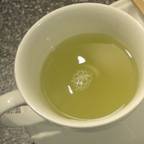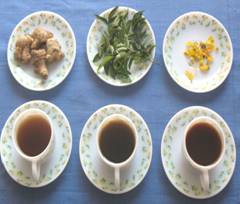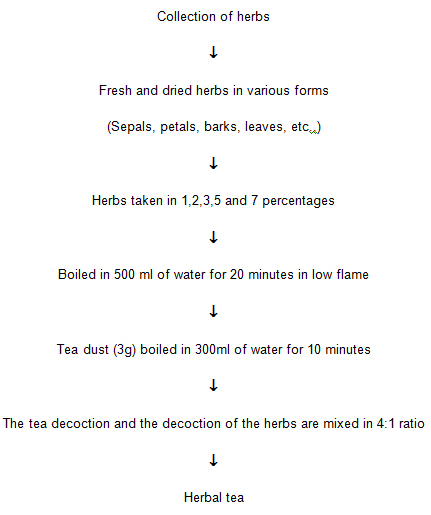Tea
Tea is a beverage prepared by pouring boiling water over dry processed leaves. Different factors affect the quality of tea like soil in which plant is grown, climate, processing techniques used etc.
Percentage composition of tea leaves
| Constituents |
% |
Constituents |
% |
| Polyphenols |
22.2 |
Ash |
5.6 |
| Protein |
17.2 |
Reducing sugars |
3.5 |
| Caffeine |
4.3 |
Pectins |
6.5 |
| Crude fibre |
27.0 |
Ether extract |
2.0 |
| Starch |
0.5 |
|
|
 TYPES OF TEA* TYPES OF TEA*
Black tea
Various processing steps involved in the manufacture of black tea are withering, rolling, fermentation, drying, grading and packing.
Green tea
 Here withering and fermentation are completely omitted. It is made by first steaming the leaves to prevent the leaves from changing colour and to inactivate the enzymes. Steaming is then followed by rolling and drying. The leaves retains much of its original green colour especially the finer leaves. Here withering and fermentation are completely omitted. It is made by first steaming the leaves to prevent the leaves from changing colour and to inactivate the enzymes. Steaming is then followed by rolling and drying. The leaves retains much of its original green colour especially the finer leaves.
Oolong tea
Oolong tea is partially fermented. The fermentation period is too short to change the colour of the leaf completely. It is only partially blackened. The beverage is intermediate between those produced from green and black teas.
Characteristics of tea beverage
High quality tea beverage is clear and bright. A flavour full cup of tea has a quality known as briskness but a subtle aroma.
The strength of the beverage determines whether the tea is mild or robust.
Green tea is a pale straw colour where as black tea is deep amber.
Some astringency is inherent in tea but green tea beverage is more astringent than black.
Processing
The fresh tea leaves are placed in withering troughs set on wire mesh. Large fans blow air through the leaves to reduce the moisture content. The leaves must be evenly spread so that uniform withering occurs. The leaves must be spread by hand and all lumps or piles removed so that maximum air flow reaches all the leaves and no heat is generated in the tea. Moisture content is lowered by about 70% or to a predetermined level depending on the condition of the leaf.
For proper withering to occur, the air must be at the proper temperature. If the leaf is wet, the air is heated slightly for a short time to help remove excess moisture.
After withering, the leaves are rolled by large rolling machines to provide a twist to the leaves and to break the cell walls to expose the inside to oxygen to begin the oxidation process. The leaves are fed down onto the machines directly from the withering troughs which are overhead on the second floor.
The sifter separates particles by size. Small leaves which have been rolled successfully the first time fall to the bottom and then are moved to the next process. The larger particles which fall off the end go back to be rolled again.
Green teas skip the fermentation stage and go directly to the drying room. Leaves for black and oolong teas however, are spread evenly on special raised flat beds to allow fermentation to the desired degree. Although the process has been traditionally called "fermentation" it is actually an oxidation process that depends on tea enzymes reacting to oxygen. Temperature control is critical. The cooling ducts at the top of the room help maintain the desired temperature.
The chemical reactions taking place in the leaves directly affect the cup quality and determine the aroma and briskness of the brew.
Fermentation must be strictly regulated to produce good tea.
Next, the tea leaves travel up a conveyor belt to the dryer. They pass through the dryer at controlled temperature for about 24 minutes or longer if necessary. The goal is to stop the fermentation process and transform the tea into a stable product.
After drying the tea must cool down before the sorting and grading process. If the sorting takes place while the tea is still warm it can lose its character and bloom.
The first step in the process is passing the bulk tea through machine sorters which do most of the size grading - whole leaf, broken leaf, fannings. They are then hand graded to further fineness. The tea all comes from the same plant but the grading separates the leaves by size. Broken leaves and fannings work well in teabags while whole leaves are reserved mostly for loose tea brewing.
I. RAW MATERIAL
Two to three leaves and a bud is recommended as raw material for processing black tea in South India. The reason for the requirement of two/three leaves and a bud is due to the fact that chemicals which contribute to the quality contained in the tender leaves are in greater proportion.
Therefore, recommended shoot composition in South India for Quality Black Tea manufacture are:
Two/three leaves and a bud and single/two leaf banjis : 85%
Immature shoots : 5%
Coarse leaf : 10%
Over ten per cent of coarse leaf in the shoot composition:
-
Affects the chemical composition of the shoots.
-
Withers very slowly, leads to uneven wither which primarily causes flake and mixed infusion.
-
Complete maceration of coarse leaf is also difficult and results in improper cell disruption and poor fermentation.
II. WITHERING: (Physical/Chemical Withering)
Physical Withering is to remove the moisture from the green leaf and condition the leaf from turgid to elastic to facilitate better rolling. In addition to physical changes, the following bio-chemical changes occur to get better quality:
a. Polyphenoloxidase activity is increased which enhances the rate of fermentation.
b. Proteins are hydrolyzed to amino acid which is responsible for aroma of the tea.
c. Caffeine content is optimized which influences black tea quality.
d. Level of organic acids is enhanced which contribute to flavour of tea.
Quality surveillance steps during withering process:
a. Use ambient air when hygrometric difference is above 3ºC.
b. If the hygrometric difference is below 3ºC, use hot air with suitable proportion of ambient air.
c. The temperature of hot air should be below 35ºC.
d. To get even wither, the trough should be loaded with 2-3 kg/sq. ft. of green leaf.
e. Well ventilated lofts and access for drawing large volume of air is essential.
f. The ideal qualities of air for withering are low dry bulb temperature with high hygrometric difference.
g. Use reversible air flow system to get better withering and to avoid more handling of leaves manually.
h. Tapering cross section in the plenum chamber helps to maintain uniform pressure throughout the length of the trough.
III. ROLLING
The primary objective of rolling is to crush the leaf into small sizes. In addition, it presses out the juice and a thin film of juice is coated on the surface of the leaf particle to enhance chemical changes.
Quality assurance in the rolling process:
1. Use green leaf sifter to avoid jamming of machine.
2. Use leaf shredder to avoid over heating of dhool in the rotorvane.
3. A ball breaker is essential after the rotorvane, which will cool the tea before feeding into the CTC. Temperature of the rotorvane tea should not reach above 35ºC which reduces the enzyme activity.
CTC MACHINE
To maintain zero-defect in quality, the following should be checked regularly:
a. The temperature after each cut-every two hours.
b. The size and style of the leaf from all the machines-every two hours.
c. The moisture content after shredding (70-72%) and after fifth cut (60%).
d. Magnet may be fixed on all the conveyers.
e. Ensure daily cleaning of CTC machine.
IV. FERMENTATION
Fermentation is to bring about the chemical changes necessary to make tea liquor palatable. It is an oxidation process by which the rolled leaf looses its green colour and acquires copper colour. It also results in the formation of aroma of the fermented tea.
Error prevention process during fermentation
a. Co-current air flow arrangement is essential to supply more oxygen during the initial stage of fermentation.
b. The air should be fresh, cool and saturated with moisture.
c. The optimum temperature of dry bulb should range between 25ºC and 27ºC and the relative humidity of the air should be around 95%.
d. A post fermentation ball breaker is essential.
e. Fermenting drum must be cleaned with hot water or steam to avoid bacterial contamination.
V. DRYING
The drying process arrests fermentation and reduces the moisture content in the fermented tea from 55-60% to 2-3%.
Key points for value-adding to quality, during drying:
a. Maintaining exact inlet and exhaust temperature is important to get uniform firing.
b. Proper loading of drier is also essential to get uniform firing:
c. Maintaining drying time and temperature is very important.
-
Longer the drying time - detrimental to quality & flavour.
-
Shorter the time - results in thin liquor.
-
Higher the temperature - results in bitter tea.
d. In the ECP drier, the optimum inlet temperature for CTC process is 100±5ºC, while exhaust temperature is maintained at 55ºC.
e. In the FBD drier, the desirable inlet temperature ranges from 120-125ºC, while the exhaust temperature is maintained at 60-65ºC.
f. Magnet can be fixed in the drier mouth, which will help in removing iron particles from made tea.
VI. SORTING AND GRADING
Sorting is to remove fibre from the bulk tea and separate the tea particles into various shapes and sizes relevant to trade requirements.
a. Sorting enhances the appearances and quality of liquor.
b. Flakes of coarse leaf in the primary grade can be separated to avoid harshness.
c. Use of stainless steel meshes is desirable for good sorting.
d. Meshes should always be tight; loose meshes cause loss of bloom and uneven grading.
VII. STORAGE AND PACKING
Black tea, being a highly hygroscopic material picks up moisture from the atmosphere, if packing is not proper.
a. Three per cent (3%) moisture level is advisable when packed – if the moisture content of tea reaches 6% the keeping quality is impaired.
b. Tea should not be stored in open condition.
c. Use of bins for storage of the finished product is very essential.
d. Tea should be cooled to ambient condition, before it is taken to bins.
e. Tea can be passed under powerful magnet grills to ensure iron free tea while packing.
PREPARATION OF HERBAL TEA**


TECHNOLOGIES AVAILABLE
* - UPASI, KVK, Conoor.
** - Home Science College and Research Institute, TNAU, Madurai.
SOURCE
http://www.health-fitness.com.au/images/green-tea11.JPG
http://www.topnews.in/health/files/black-tea.jpg |

 TYPES OF TEA*
TYPES OF TEA* Here withering and fermentation are completely omitted. It is made by first steaming the leaves to prevent the leaves from changing colour and to inactivate the enzymes. Steaming is then followed by rolling and drying. The leaves retains much of its original green colour especially the finer leaves.
Here withering and fermentation are completely omitted. It is made by first steaming the leaves to prevent the leaves from changing colour and to inactivate the enzymes. Steaming is then followed by rolling and drying. The leaves retains much of its original green colour especially the finer leaves.
